8 Great New England Summer Drives
From the jagged shoreline of Maine to the verdant farmland of Vermont, these eight great New England jaunts give you the perfect excuse to plan the perfect summer road trip.

8 Great New England Summer Drives
Photo Credit : Raymond Forbes llc/stocksy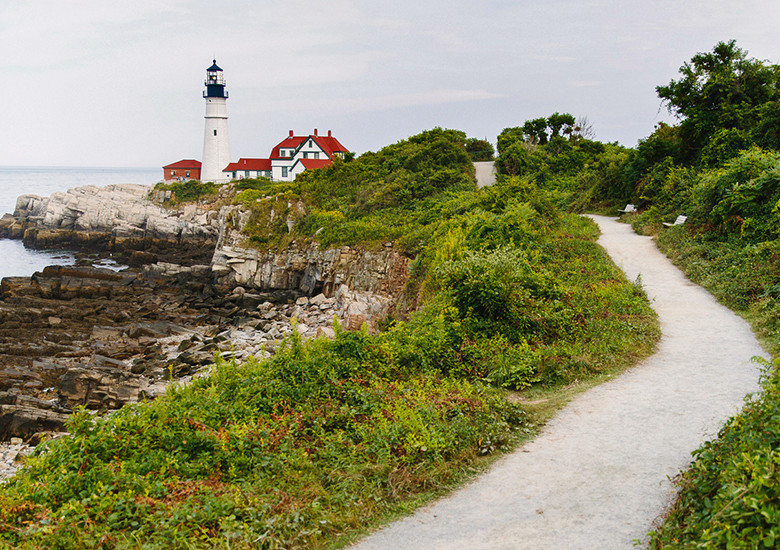
In New England, we don’t drive simply to get from point A to point B in the shortest possible time. Instead, we like to linger, savor the beauty, cherish the history. We’re fortunate to be blessed with a diverse landscape full of such majestic sights as the jagged shoreline of Maine, the granite notches of New Hampshire, the verdant farmland of Vermont, and the long stretch of white beach in Rhode Island. We stop not only to post photos to our Instagram and Facebook accounts, but also to dine on lobster rolls and fried clams at renowned seafood shacks, hike on the same shoreline and forest paths that inspired Winslow Homer and Robert Frost, and stay at legendary inns or, say, a new cabin built in the vast Maine wilderness. Where to start? These eight drives will not disappoint.
8 Great New England Summer Drives
Kennebunkport to Cape Elizabeth (Maine) | A Painterly Perspective
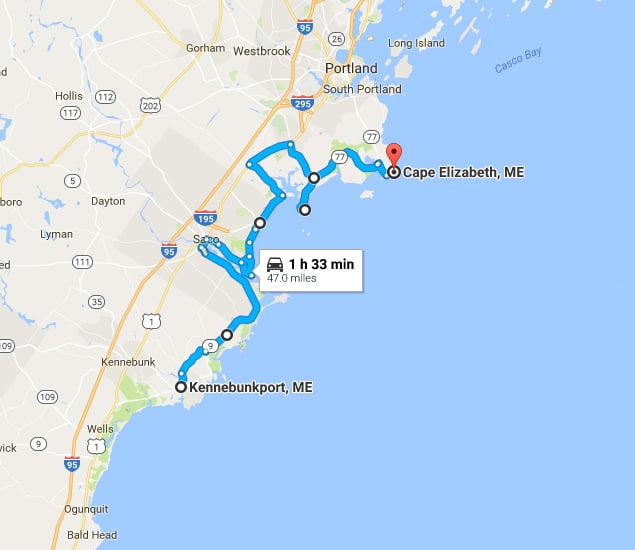
Distance: 47 miles
Stick to the slower roads that hug the southern Maine shoreline (Routes 9 and 77), and you’ll be treated to the same rugged landscape that inspired Winslow Homer to set up shop in Prouts Neck. Indeed, Homer’s studio, now open to the public thanks to a $10 million renovation by the Portland Museum of Art, is one of the many highlights of this drive. Drop off your bags at the venerable White Barn Inn in Kennebunkport (which recently went though its own renovation, updating all 11 rooms and adding an outdoor sitting area), then make your way past the 7-mile length of Old Orchard Beach to reach Prouts Neck, where Homer would depict this craggy shoreline in its entirety. Prearrange a tour of his simple two-story studio with the Portland Museum of Art, and take the mile-long Prouts Neck Cliff Walk to see the waves thrust up against the rock painted so brilliantly in his many canvases.
Then it’s onward to Cape Elizabeth on back roads where glimpses of the ocean are always at your side. If you’re feeling hungry, head to the beloved lobster-in-the-rough joint, the Lobster Shack. Order your food at the window of the rustic shack, wait for your number to be called, and grab a picnic table that rewards you with vistas of the Atlantic as it pours into Casco Bay, framed by two lighthouses. Just down the road is the last stop on this drive, the Portland Head Light—arguably the most photographed and painted lighthouse on the New England coast. Built in 1791 and perched on a bluff above the sea, the exquisite white edifice of the Portland Head Light has inspired the likes of Edward Hopper. Stroll around its 80-foot height and then hit the trails that line the shore. Lobstermen haul up traps from the back of their boats; farther out to sea, oil tankers make their way in and out of Portland Harbor. Breathe in as much salty air as you need before making the return trip.
Old Saybrook to Hadlyme (Connecticut) | Connecticut River Amble

Distance: 23 miles
Old Saybrook is where the Connecticut River meets the Long Island Sound, and it’s a good starting point for a drive that hugs New England’s most famous river along Route 154. Start this drive south of Old Saybrook at Knollwood Beach, then continue north through cattails and salt marsh to the historic hub of Essex.In the mid-1800s, this section of the Connecticut River was lined with more than 50 shipyards. Boats would return from international waters with spices from the West Indies and ivory from Zanzibar. The result of that newly acquired wealth is the collection of large colonial and Federal-style homes that border the water’s edge and can be viewed as you continue north on Route 154.
In Tylerville, veer right on Route 82 across a drawbridge into East Haddam, site of the four-story gingerbread-style Goodspeed Opera House. Opened in 1877, this theater staged the original productions of Annie and Shenandoah and still delivers three musicals a year. The Goodspeed is the mere opening number to the theatrics you’ll see at your next stop, Gillette Castle. William Gillette amassed a fortune playing Sherlock Holmes onstage at the turn of the last century, but judging from the medieval-style fortress he designed on a vista overlooking the river, he might have been better suited to play King Arthur. You can tour the 24-room behemoth and walk the grounds over trestles and through tunnels before heading downhill to the Hadlyme docks. Ferry across the river and drive 10 minutes to Deep River to a circa-1854 home that is now the welcoming Riverwind Inn, where you can savor the serenity of the Connecticut River Valley in one of the front porch rocking chairs.
St. Johnsbury to Lake Willoughby (Vermont) | A Carpet of Velvety Green
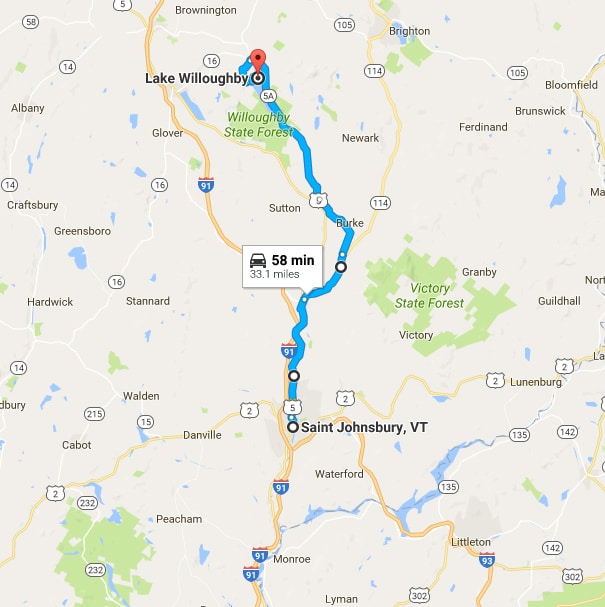
Distance: 33 miles
In a state known for its rural landscape (only Wyoming and Alaska contain fewer people), the Northeast Kingdom is Vermont putting on its finest pastoral dress.Wave after wave of unspoiled hillside form a vast sea of green, and small villages and farms spread out in the distance under a few soaring summits. Start this drive at the St. Johnsbury Athenaeum, where leather-bound books share space with a 19th-century art gallery that includes Albert Bierstadt’s monumental 10-by-15-foot painting, The Domes of the Yosemite.Across the street, the Fairbanks Museum is home to more than 3,000 preserved animals in glass cases, among them a 1,200-pound moose, an American bison from 1902, and a Bengal tiger.
It’s no surprise that this sylvan countryside is the perfect playground for outdoor activities. Continue north on Routes 5 and 114 to reach East Burke and the vast network of mountain bike trails called the Kingdom Trails. With this soft forest passageway dusted with pine needles and leading through century-old farms, the town has arguably created the finest off-road riding in New England. The huge barns that once housed the Jersey cows and Morgan horses of Elmer Darling in East Burke are now part of the 14-room Inn at Mountain View Farm, the obvious choice for spending the night and taking in this bucolic splendor.
Continue north on Route 5A to find one of the most stunning vistas in Vermont.Arriving at Lake Willoughby from the south, you’ll see the dark blue waters come into view, dwarfed by faces of rock that stand directly across from each other: Mount Hor and Mount Pisgah. Cliffs plummet more than 1,000 feet to the glacial waters below, creating essentially a landlocked fjord.The scenery is best appreciated on the three-hour hike to the 2,751-foot summit of Mount Pisgah. Afterward, reward yourself with a dip in the cool waters of the lake.
Jackson to Dixville Notch (New Hampshire) | Drive Through the Notches
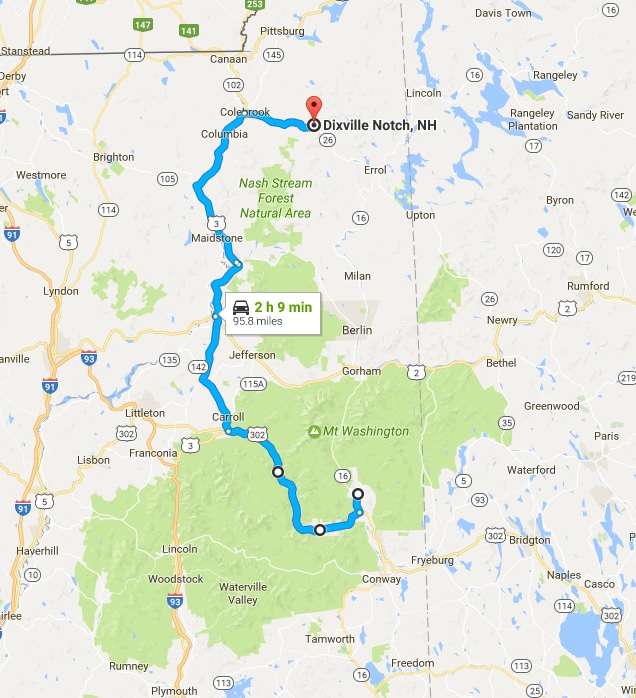
Distance: 96 miles
The glacier that retreated 10,000-plus years ago to form the White Mountains seems to have left in a hurry, having neglected to smooth the edges of the rocky detritus that remained. Narrow and steep mountainous passes, called notches, cut sharply through walls of granite that refused to budge. Driving through Crawford Notch, a sinuous 6-mile mountainous pass, has been a highly popular route since the stagecoach days.
Start this drive in the charming hamlet of Jackson, and follow Route 302 west into the notch. To truly appreciate this sculpture of granite, park your car at the Crawford Notch Visitor Center, former site of the Crawford railroad station, and take the hike up Mount Willard. In less than an hour you’ll make it to the peak, where jaw-dropping views of Crawford Notch stand below you, a reward for your slight efforts.
As soon as you leave Crawford Notch and continue on Route 302, New England’s largest peak, Mount Washington, looms mightily above (although it could very well be blanketed with clouds). Situated in front of Mount Washington, like a sprawling wedding cake with scarlet frosting, is one of the grand dames of New England lodging: the Mount Washington Hotel. First opened in 1902, this National Historic Landmark has hosted such luminaries as Thomas Edison, Winston Churchill, and Alfred Hitchcock. You might want to drop your luggage off here and return that evening to dine downstairs at the American bistro Stickney’s. You can also choose to take the nearby Mount Washington Cog Railway and watch the coal-fired engines of this train propel it up the mountain’s precipitous granite flanks.
To add a three-hour loop to this drive, head north on Route 3 to Colebrook and then follow Route 26 east to Dixville Notch, the narrowest notch in New Hampshire. Carved between Sanguinary Mountain and Mount Gloriette, the rocky cleft barely allows the two-lane road to squeeze through. Standing across from the once famous and now defunct Balsams Resort, the notch is now part of a state park replete with waterfalls, flume, and hiking trails. The short, steep climb up to Table Rock leads to an exposed ledge that juts out over a cliff and offers stupendous views.
Wickford to Watch Hill (Rhode Island) | Rhode Island Beach Ramble
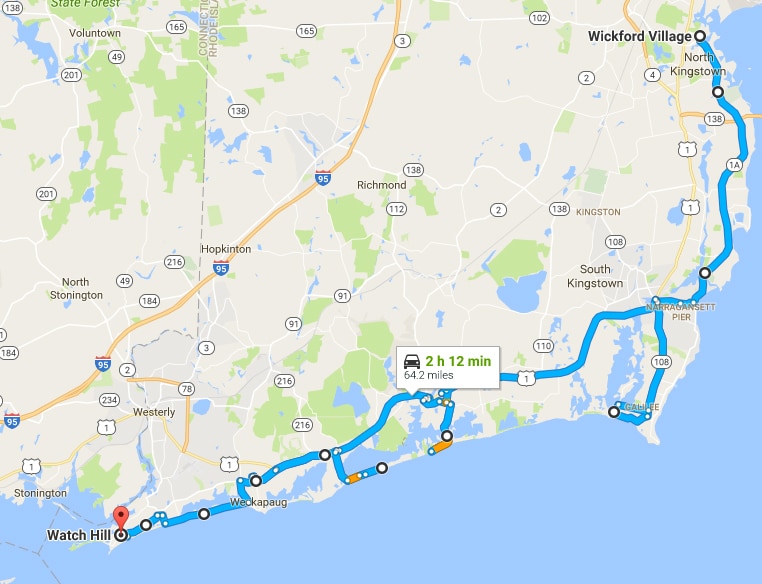
Distance: 64 miles
The western half of Rhode Island’s Narragansett Bay, far away from the crowds in Newport, is perfectly suited for a relaxed drive along the sea and marsh leading to small villages that have been summer getaways for over a century. Start in Wickford to watch the fishermen and sea kayakers navigate past the docked yachts in the quiet harbor. Follow Route 1A south to reach the surfing community of Narragansett. In summer the waves are much milder, attracting families who can easily walk to the lodging and restaurants in town. A wise choice is the boutique property the Break, and its restaurant, Chair 5, featuring oysters, lobster, and calamari straight off the docks.
Stop at the rock jetty at Roger Wheeler Memorial State Park in Galilee to watch the ferries come to and from Block Island. Then continue west past a series of popular beaches, such as East Matunuck State Beach in South Kingstown, petite Blue Shutters Town Beach in Charlestown, and Misquamicut State Beach, Rhode Island’s best honky-tonk beach. Atlantic Avenue’s hotels, bars, restaurants, water slides, and miniature golf courses back 7 miles of oceanfront. Ten minutes later, the Victorian-era homes clinging to the hillside are a sign that you have arrived in the classic summer retreat of Watch Hill. Take a ride on one of the oldest carousels in the country, visit the small array of shops and restaurants, or opt for one of the finest coastal walks in the region at Napatree Point. Waves crash on your bare feet as you stroll on Napatree’s crescent-shaped beach. As you reach the point, the winds begin to howl, the surf seems a little bit more ominous, and the sand changes to large battered rocks.
Rockport to Ipswich (Massachusetts) | Cape Ann Cruise
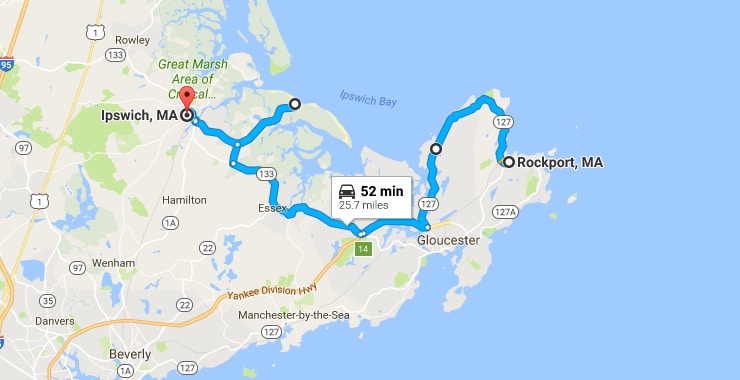
Distance: 26 miles
Cape Ann is the other cape,the one we New Englanders like to keep a secret. Like Cape Cod, the miles of sublime beachfront here are the region’s number one attraction. But dig a little deeper and you’ll find centuries-old New England villages to roam, the finest fried and steamed clams in the region, and wonderful opportunities to sea kayak in sheltered waters and to stroll along the Atlantic. Start in Rockport to walk the strip of shops known as Bearskin Neck. Art galleries share the street with restaurants on the piers that overlook Rockport’s postcard-perfect harbor. A 10-minute drive outside of town on Route 127 north brings you to the recently renovated Emerson Inn, Cape Ann’s grand hotel, well situated for dinner in Rockport and perhaps a show at the contemporary Shalin Liu Performance Center. Just up the road is Halibut Point State Park: Get out of the car to visit the large quarry in the center of the park, now filled with 70-plus years of rainwater, then take the wide gravel path past countless large boulders that line the shoreline for a wide-ranging vista of the coastline north to Plum Island.
Continue on 127 north to find the small seaside community of Annisquam, and then take Route 133 west to reach Essex. If it’s anywhere near lunch or dinner time, you’ll no doubt spot a line out the door at the legendary seafood shack Woodman’s, the place where the fried clam was reportedly created on July 3, 1916. Queue up to order lobsters of every size imaginable, buckets of tender Ipswich clams (fried or steamed), fried shrimp, corn on the cob, and mounds of onion rings.Around the bend on Route 133, you’ll reach the home of Essex River Basin Adventures, an outfitter that offers exhilarating two-hour guided kayaking tours through the web of estuaries in the Essex Marsh.
To find your own spit of sand on 4-mile-long Crane Beach, turn right on Argilla Road before reaching the historic town of Ipswich. Pull over just before the beach at Russell Orchards, in operation since 1920. You’ll find just-baked cider doughnuts, muffins, apple cider, hard cider, and fruit-flavored wine, or head out into the fields to pick your own strawberries and apples. Also, visit the impressive grounds of the Crane Estate next door to the beach in order to roam the half-mile-long Grand Allée that leads from the Great House to the sea. This is Massachusetts’s version of Versailles.
Rangeley to Kingfield (Maine) | The Maine Moose Run
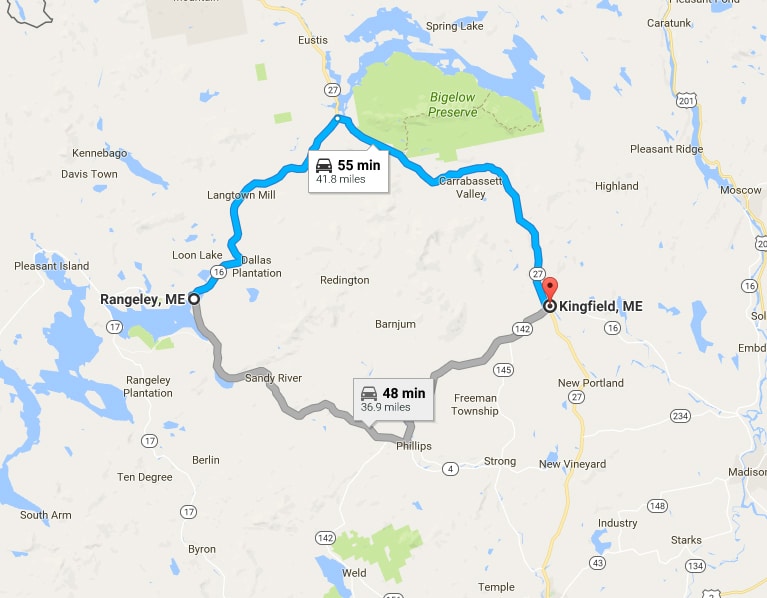
Distance: 42 miles
The Maine interior is one of the most undeveloped regions in the Northeast, a blanket of forest filled with mile-high mountains traversed by the Appalachian Trail, colossal lakes, long rivers such as the Kennebago and Penobscot, and too many ponds to count. Many Mainers consider the small village of Rangeley, the main hub of the Rangeley Lakes Region, as the gateway to this vast tract of land. It’s not surprising, then, that Rangeley hosted a Maine moose-calling contest several summers ago. That moose call may come in handy when you drive out of town on Route 16 north to Stratton. At dawn or dusk, moose seem as prevalent as squirrels in suburbia.
In Stratton, head south on Route 27 to Carrabassett Valley, home to Sugarloaf Mountain Resort and the Sugarloaf Outdoor Center. Rent a bike and venture onto the vast network of trails that loop around lonely ponds and along streams, always with broad-shouldered Sugarloaf Mountain in the background. Expert bikers can tackle the newly cut Oak Knoll Trail, which makes its ascent some 600 feet up to your lodging for the night, Stratton Brook Hut, the latest property to be built by Maine Huts and Trails. Hikers can make the 90-minute climb under the tall pines on Newton’s Revenge Trail. Once at the hut, reward yourself with a Baxter Stowaway IPA and stroll over to “The Vista.” A bench looks out on a wide swath of uninterrupted wilderness that includes the Bigelow Range, 4,000-foot peaks that form the backbone of a ridge walk on the Appalachian Trail.
Back at the trailhead, continue on to Kingfield for a requisite burrito stop at Rolling Fatties. Then you can loop back to Rangeley or head an hour north to the Forks to go whitewater rafting on the Kennebago River. If you want to put that moose call to work once again, head 90 minutes north of Kingfield to Greenville and Moosehead Lake, home to the Moose Cruise.
Warren loop (Vermont) | Shoot the Gaps
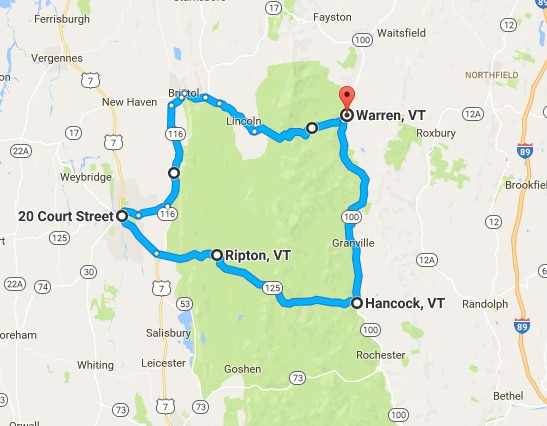
Distance: 61 miles
In Vermont, they call them “the gaps”—narrow roads that cut through the otherwise impassable ridge of the Green Mountains, offering astounding vistas and providing backcountry access to the Long Trail, the state-long hiking route. Begin in Warren at the Pitcher Inn, where more than 40 local artists combined their talents to give this Relais & Chateaux property a distinctly Vermont feel; in the Trout Room, for example, birch trees were used to create the bed frame, a fly-fishing desk is fully stocked, and a semicircular veranda overlooks a rambling stream. Then saunter across the street to the Warren Store to grab a Dagwoodesque sandwich on thick French bread.You’ll want it for the first stop of the day, Sunset Ledge.
Drive west on the Lincoln Gap and rise to the top of the crest, where you’ll find a parking lot on the left-hand side of the road. Continue on foot on the Long Trail, heading south, and a little over a mile later you’ll reach Sunset Ledge. The Adirondacks can be seen to the west, past the rolling tapestry of farmland and meadows. Just to your north, in the Green Mountains, is the 4,017-foot peak of Mount Abraham. Get back into the car and head downhill into Lincoln and onward to Bristol and Middlebury on Routes 16 and 7 south. Home to stately college buildings, a rare double-barreled covered bridge (Pulp Mill), and tasty fare overlooking a waterfall at the Storm Café, Middlebury is definitely worth a stop.
Continue on Route 7 south to Route 125 east to reach Ripton, the start of the Middlebury Gap and former home of poet laureate Robert Frost. For 39 years, he would summer in a log cabin hidden on the hillside. The mile-long Robert Frost Interpretive Trail is a good introduction to his work, as you amble through the forest while reading seven Frost poems on signs. Continue your drive upward for more glorious views of the mountain wilderness. Once you reach the farming community of Hancock, continue north a wee bit further on Route 100 to complete the loop back in Warren.
A regular contributor to Yankee, Steve Jermanok also wrote the stories “The 25 Best Beach Towns in New England” and “The 10 Best Winter Towns in New England.”


